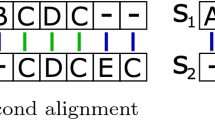Abstract.
In this article, a new method is illustrated for mining navigation patterns on a web site. Instead of clustering patterns by means of a Euclidean distance measure, in this approach users are partitioned into clusters using a non-Euclidean distance measure called the Sequence Alignment Method (SAM). This method partitions navigation patterns according to the order in which web pages are requested and handles the problem of clustering sequences of different lengths. The performance of the algorithm is compared with the results of a method based on Euclidean distance measures. SAM is validated by means of user-traffic data of two different web sites. Empirical results show that SAM identifies sequences with similar behavioral patterns not only with regard to content, but also considering the order of pages visited in a sequence.
Similar content being viewed by others
References
19991 Borges J, Levene M (1999) Data mining of user navigation patterns. In Web usage analysis and user profiling: 92-111. Lecture notes in computer science, vol 1836. Springer, Berlin
19992 Büchner AG, Baumgarten M, Anand SS et al (1999) Navigation pattern discovery from internet data. In ACM workshop on web usage analysis and user profiling (Webkdd), San Diego, CA, August 1999
19983 Büchner AG, Mulvenna MD (1998) Discovering internet marketing intelligence through online analytical web usage mining. SIGMOD Record 27(4): 54–61
20004 Cadez I, Heckerman D, Meek C et al (2000) Visualization of navigation patterns on a web site using model based clustering. Technical Report, University of California
20015 Capri (2001) Generic sequence discovery product, http://www.mineit.com/products
19956 Catledge L, Pitkow J (1995) Characterizing browsing behaviors on the World Wide Web. Computer Networks and ISDN Systems 27(6): 1065–1073
20007 Cooley R (2000) Web usage mining: discovery and application of interesting patterns from web data. University of Minnesota, http://www-users.cs.umn.edu/cooley/pubs.html
19998 Cooley R, Mobasher B, Srivastava J (1999) Data preparation for mining World Wide Web browsing patterns. Knowledge and Information Systems 1(1):5–32
20009 Cooley R, Tan P-N, Srivastava J (2000) Discovery of interesting usage patterns from web data: advances in web usage analysis and user profiling. Lecture notes in computer science, vol 1836. Springer, Berlin
198010 Everitt B (1980) Cluster analysis. Halsted Press, New York
199811 Hair JF, Andersen RE, Tatham RL et al (1998) Multivariate data analysis. Prentice-Hall, Engllwood Cliffs, NJ
2001a12 Joh CH, Arentze TA, Timmermans HJP (2001a) A position-sensitive sequence-alignment method illustrated for space-time activity-diary data. Environment and Planning A 33(2): 313–338
2001b13 Joh CH, Arentze TA, Timmermans HJP (2001b) Multidimensional sequence alignment methods for activity-travel pattern analysis: a comparison of dynamic programming and genetic algorithms. Geographical Analysis 33(3):247–270
199814 Krishnapuram R, Joshi A (1998) Robust clustering methods to support web mining. In ACM SIGMOD workshop on research issues in data mining and knowledge discovery, Philadelphia, PA, June 1998
199715 Mannila H, Ronkainen P (1997) Similarity of event sequences. In Proceedings of the 4th international workshop on temporal representation and reasoning, TIME IEEE Computer Society, May 1997
199616 Mobasher B, Jain N, Han E, Srivastava J (1996) Web mining: pattern discovery from World Wide Web transactions. Technical Report TR 96-050, University of Minnesota, Department of Computer Science, Minneapolis
200017 Mobasher B, Dai H, Luo T et al (2000) Discovery of aggregate usage profiles for web personalization. In Proceedings of the WebKDD Workshop, August 2000
200018 Mulvenna MD, Anand SS, Büchner AG (2000) Personalization on the net using web mining: introduction. Communications of ACM 43(8): 122–125
199919 Nasraoui O, Krishnapuram R, Anupam J (1999) Mining web access logs using a fuzzy relational clustering algorithm based on a robust estimator. In Proceedings of the 8th international fuzzy systems association congress, June 1999
199720 Perkowitz M, Etzioni O (1997) Adaptive web sites: an ai challenge. In International joint conference on AI, Nagoya, Japan, August 1997
199821 Perkowitz M, Etzioni O (1998) Adaptive web sites: automatically synthesizing web pages. AAAI, July: 727–732
199622 Pirolli P, Pitkow J, Rao R (1996) Silk from a sow’s ear: extracting usable structures from the web. In conference on human factors in computing systems (CHI-96), April 1996
198323 Sankoff D, Kruskal JB (1983). Time warps, string edits and macromolecules: the theory and practice of sequence comparison. Addison-Wesley, Reading, MA
200024 Shahabi C, Faisal A, Kashani FB et al (2000) INSITE: a tool for real-time knowledge discovery from users web navigation. In Proceedings of 26th international conference on very large databases (VLDB), Cairo, Egypt, September 2000
199725 Shahabi C, Zarkesh A, Adibi J et al (1997) Knowledge discovery from users web-page navigation. In Proceedings of the 7th IEEE international conference on research issues in data engineering, June 1997
199826 Spiliopoulou M, Faulstich LC (1998) WUM: a tool for web utilization analysis. In EDBT workshop WebDB, March 1998. Springer (extended version in LNCS, vol 1590)
199927 Spiliopoulou M, Faulstich LC, Winkler K (1999) A data miner analysing the navigational behaviour of web users. In Proceedings of the workshop on machine learning in user modelling of the ACAI international conference, July 1999
200028 Spiliopoulou M, Pohle C, Faulstich L (2000) Improving the effectiveness of a web site with web usage mining. In Masand and Spiliopoulou: pp 139–159
199629 Srikant R, Agrawal R (1996) Mining sequential patterns: generalizations and performance improvements. In Proceedings of the 5th international conference on extending database technology, March 1996
200030 Srivastava J, Cooley R, Deshpande M et al (2000) Web usage mining: discovery and applications of usage patterns from web data. In SIGKDD explorations 1(2): 12–23
199831 Wilson WC (1998) Activity pattern analysis by means of sequence alignment methods. Environment and Planning A(30): 1017–103
Author information
Authors and Affiliations
Corresponding author
Rights and permissions
About this article
Cite this article
Hay, B., Wets, G. & Vanhoof, K. Mining Navigation Patterns Using a Sequence Alignment Method. Knowledge and Information Systems 6, 150–163 (2004). https://doi.org/10.1007/s10115-003-0109-6
Received:
Revised:
Accepted:
Issue Date:
DOI: https://doi.org/10.1007/s10115-003-0109-6




